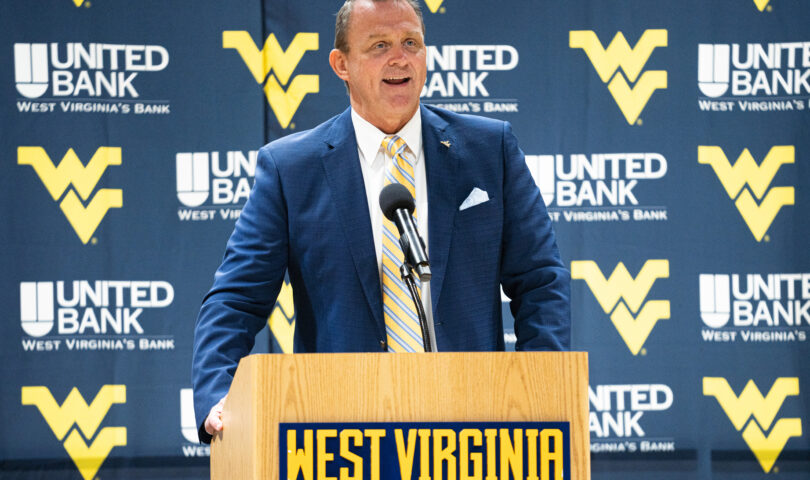MORGANTOWN — If anyone out there has about $40 or $50 million simply lying around, the WVU athletic department would like to speak with you very soon.
That’s the projected amount it’s going to cost WVU as it moves forward with potential changes in the athletic department, beginning with the firing of athletic director Shane Lyons on Monday.
It is here we really want to highlight the word “projected,” because if there was one thing interim AD Rob Alsop stressed Monday is that Lyons’ removal was not the first step of a two-step process that will later include the removal of football coach Neal Brown.
OK, so we’ve covered all the technical bases there, but let’s get real for a moment, it would be absolutely foolish to think that a newly-hired athletic director won’t at least entertain the thought of replacing a struggling coach of the biggest money-maker in town.
And this is where we get into the dollars and cents and ask the question: Does any of this truly make any sense?
Lyons’ contract with WVU — he just signed an extension on Jan. 14, 2022 — ran through Dec. 31, 2026.
According to the contract, Lyons’ buyout will pay him his remaining base salary, which was set to go up from $895,000 to $931,000 next year.
So, you’ve got four years at $931,000, which comes out to $3.724 million right off the bat.
There are other provisions in his buyout dealing with performance incentives and retention incentives that are dealt with on some type of prorated basis.
We’ll not bore you with those details, and quite frankly we don’t really understand it all to begin with, but Lyons’ buyout will be somewhere north of $4 million, which will be spread out in monthly payments for the next 24 months.
If the new athletic director comes in and wants to clean house with the football program, that’s going to be another $22 million, give or take, based on Brown’s buyout, as well as the buyouts for his assistant coaches.
Brown’s buyout would take up somewhere between $16-17 million of that.
You can see how this all adds up pretty quickly.
The Turnkey ZRG firm that WVU hired to find a replacement for Lyons, according to published reports, that firm charged the University of South Carolina $50,000 last March to find its new men’s basketball coach.
Now, 50 grand is a drop in the bucket compared to the rest of this, but for so many people in this state who support the university, $50,000 is a ton of money to simply make a bunch of phone calls to find out who is interested in a job.
WVU’s new athletic director isn’t going to work for free, either, and neither would a new football coach or assistant coaches.
This projected $40-$50 million only covers the immediate state of affairs with Lyons, his successor and the future of the football program.
The athletic department still has to pay millions toward its other coaches and their assistants.
Not to mention the $1.5 million it shells out yearly toward its Academic Incentive Program, which funds financial assistance to its athletes based on their academic progress. That money is on top of the millions already spent to fund the full cost-of-attendance stipends athletes have been receiving for the last few years.
In short, it’s not cheap to run a major Division I athletic department and it can get a lot more expensive in a hurry for WVU.
“I think we’re in a strong position,” Alsop said. “We have a really strong fan base. We’ve got a great brand and we have a number of attributes that will make us successful going forward. We have a loyal set of donors. I would say I’m confident, as we move forward as an institution that we have the resources to be competitive.”
Here’s the bigger picture, though, and everything is relative.
For instance, you may wonder what the national economy has to do with WVU athletics?
Well, anyone who has looked at their 401K plan in the last year knows it’s now worth thousands less than it was just a year ago.
If everyday people like you and me are losing thousands, what do you think WVU’s mightiest donors are losing?
Not asking you to feel sorry for them, but WVU’s expected money pool isn’t quite as deep as it once was. That’s just basic economics.
And, oh by the way, this country is headed for a projected recession in 2023, just about the same time it could be shelling out millions to people to not be the football coach or athletic director.
The fuel for those charter flights taken by the football and men’s basketball teams are more expensive. Costs to heat up the Coliseum and other facilities are more expensive. The cost to pay its coaches are not going down.
It all adds up, and maybe Alsop was simply looking on the bright side, but it’s really hard to see how WVU goes through all of these projected changes while still being in a “strong position.”
“We have had to, as we always do, do more with less,” Alsop said. “We are not blessed with unlimited resources. The past few years have been hard. I’m confident we will move forward as a strong institution.”
TWEET @bigjax3211




